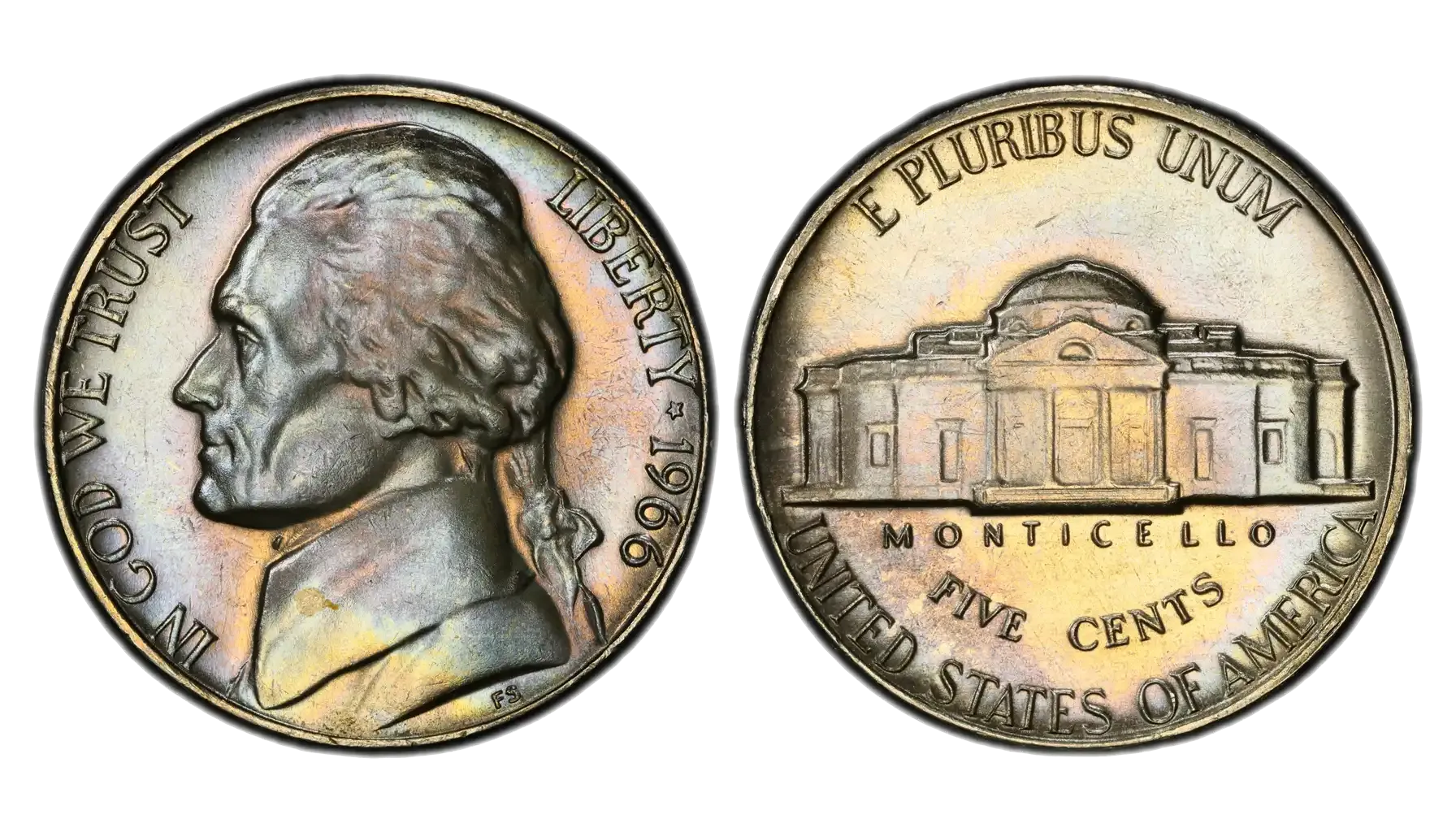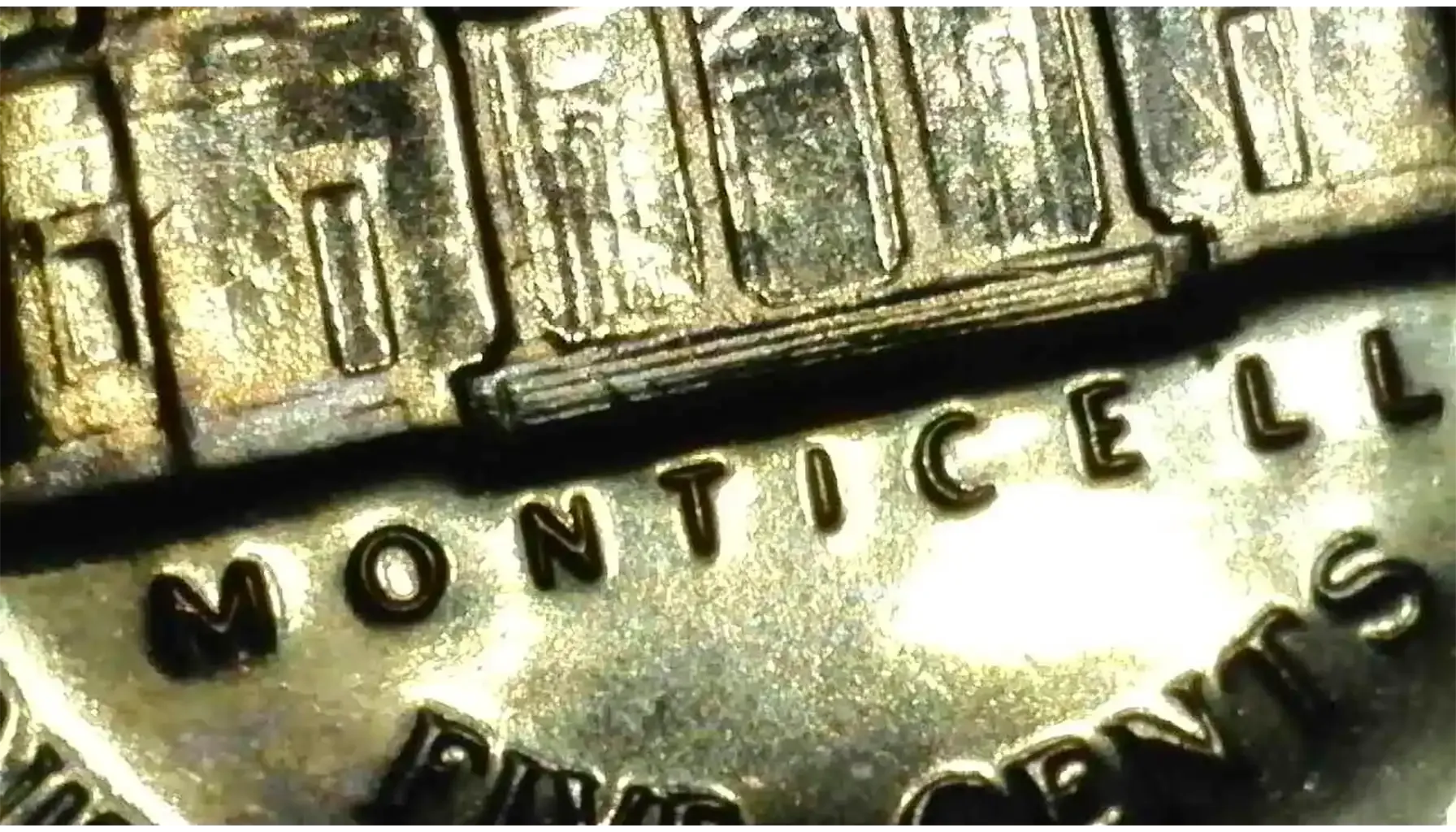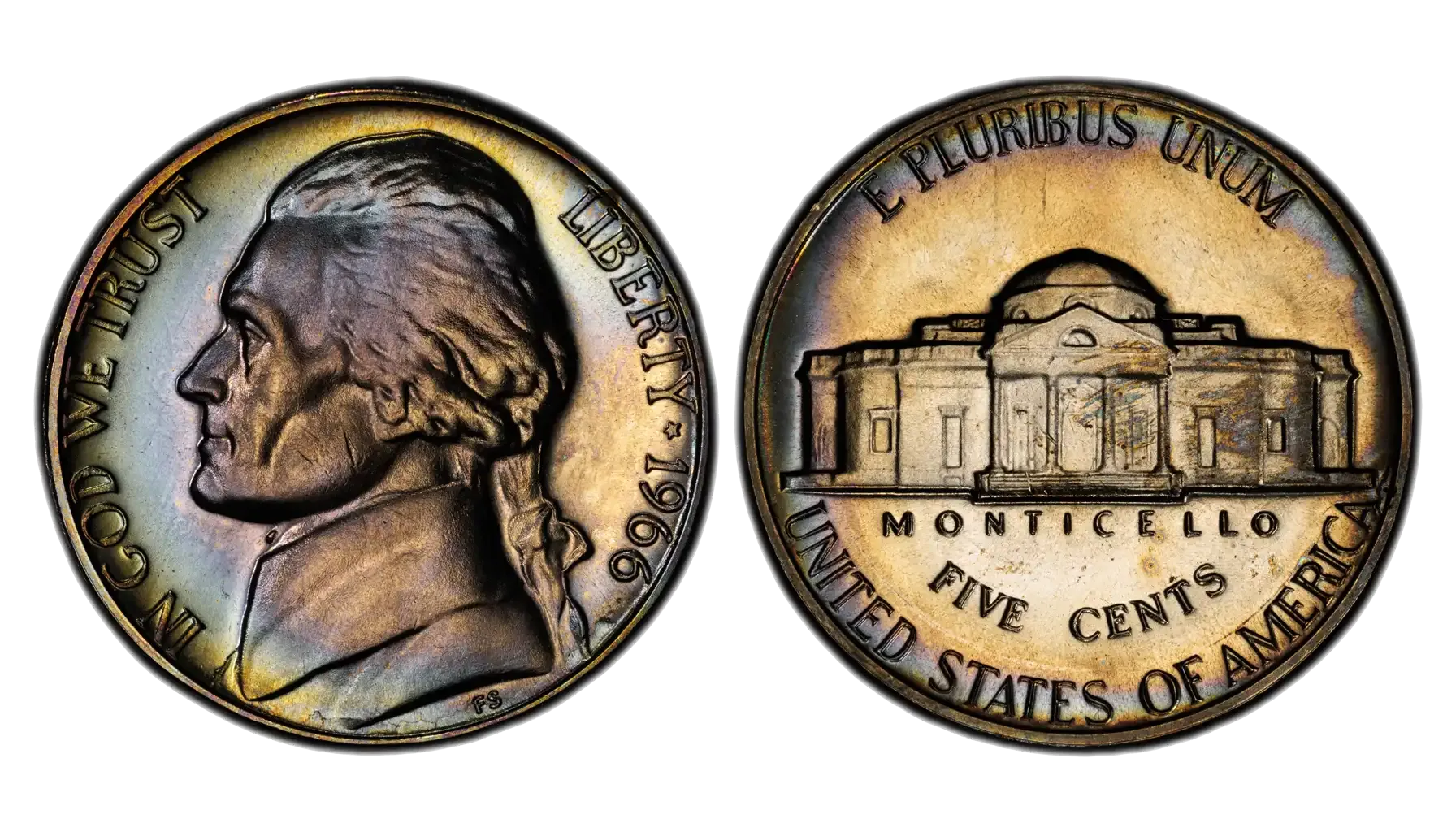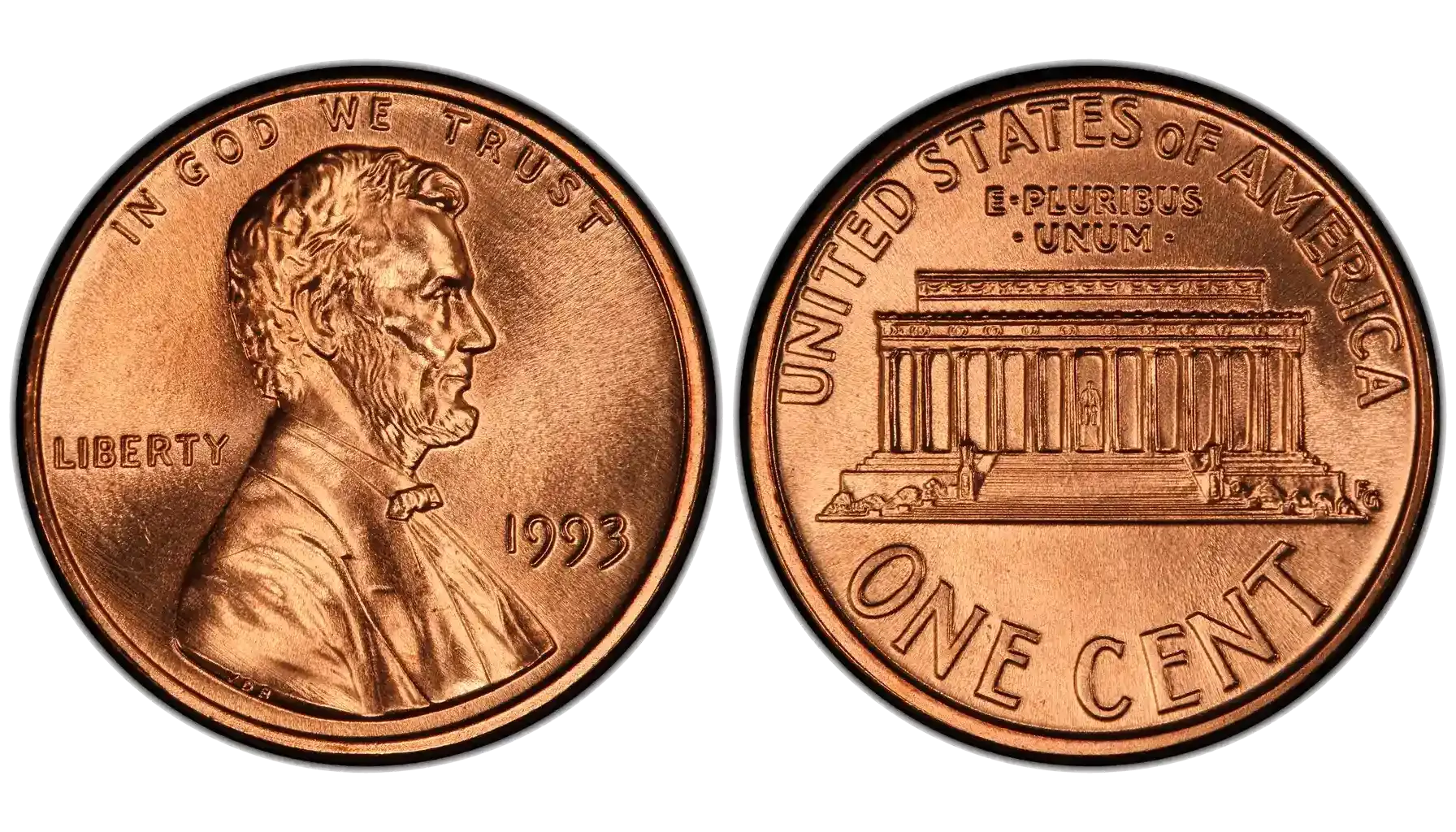Contents:
What do you think, is a 1966 nickel worth anything? This coin might cost even a few hundred dollars.
At first glance, this coin seems too ordinary to be interesting. No mint mark. No silver. Just another coin in a bowl on the dresser. But beneath its dull surface lies a series of surprises: minting quirks, preserved perfection, and 1966 nickel errors that can turn a five-cent piece into a collectible piece.
So, how much is a 1966 nickel worth? How can you identify the coins? And what else should you know about these pieces?

Specification | Details |
Denomination | 5 Cents |
Year | 1966 |
Mint | Philadelphia |
Mintage | 156,208,283 coins |
Metal Composition | 75% Copper, 25% Nickel |
Weight | 5.00 grams |
Diameter | 21.2 mm |
Thickness | 1.95 mm |
Edge | Plain (smooth, no reeds) |
Designer | Felix Schlag |
Obverse Design | Portrait of Thomas Jefferson |
Reverse Design | Monticello (Jefferson’s home) |
Mint Mark | None (no mint marks used from 1965–1967) |
Strike Type | Business Strike |
A Quick History Lesson
The mid-1960s were a chaotic time for U.S. coinage. Following the Coinage Act of 1965, silver was removed from dimes and quarters—and the U.S. Mint stopped using mint marks to deter hoarding.
The 1966 nickel, struck only at the Philadelphia Mint, carries no mint mark and was produced in large quantities: over 156 million coins.
Despite this, not all these coins are equal. Some were struck with uncommon precision, and others were victims of minting mishaps that now excite collectors and make 1966 nickels worth money.
What Makes a 1966 Nickel Valuable?
1. Condition
Collectors drool over pristine coins—especially ones that boast glowing luster and perfect detail. The grading scale ranges from Poor (P-1) to Mint State (MS-70).
Circulated examples (what you'd find in your change) are worth 5¢—maybe a bit more if they’re in Very Fine (VF) condition.
Uncirculated (MS65–MS67) coins sell for $1–$15.
Mint State 1966 Nickel Full Steps—clear, sharp lines on the steps of Monticello—can soar to $150–$300+.
Note: Only a small percentage of 1966 nickels qualify as Full Steps. That rarity drives demand.

Mint Marks
No mint marks were used on U.S. coins struck in 1966 — and that includes the Jefferson nickel.
Why No Mint Mark?
From 1965 to 1967, the U.S. Mint intentionally removed all mint marks from circulating coins. This decision was made during the national coin shortage and the transition away from silver coinage (there’s no 1966 nickel silver content). The goal was to discourage coin hoarding by reducing the appeal of coins from specific mints.
So Where Were They Actually Made?
Mint Location | Mint Mark | Used in 1966? | Notes |
Philadelphia | (none = 1966 no mint mark nickel) | Yes | All were struck here, but bear no mint mark. |
Denver | D | No | Not indicated due to the mintmark freeze. |
San Francisco | S | No | Also struck coins, but no mint marks appeared. |
Even if a 1966 nickel was minted in Denver or San Francisco, it will look the same as a Philadelphia coin — with no identifying mintmark.
If you find a 1966 nickel with a visible “D” or “S” mint mark, it's either:
A post-mint counterfeit, or
A damaged or altered coin.
Genuine ones must have no mint mark.

"Full Steps" 1966 Jefferson Nickels
The “Full Steps” designation is one of the most sought-after grading attributes for Jefferson nickels—especially for years like 1966, where high-quality strikes are uncommon.
On the reverse, beneath Monticello, there’s a series of horizontal steps. A coin with Full Steps (abbreviated FS) shows at least 5 or 6 sharply defined, unbroken steps.
Full Steps Criteria:
Minimum of 5 full steps (sometimes 6, depending on grading service)
No major nicks, bridges, or weak areas
Must be struck with unusually high precision
Only applies to uncirculated (Mint State) coins
In 1966, production quality was generally lower due to overworked dies and the mintmark moratorium. As a result, very few nickels from this year exhibit true Full Steps detail.
1966 Nickel FS Value vs. Standard 1966 Jefferson Nickel Value
Grade | No Full Steps | Full Steps (1966 FS nickel value) |
MS65 | $5–$10 | $50–$100 |
MS66 | $10–$20 | $150–$250 |
MS67 | Rarely seen | $300–$600+ |
Disclaimer: Values based on recent certified sales via PCGS, NGC, and Heritage Auctions.
How to Spot a Full Steps Piece
A 10x–20x jeweler's loupe or coin microscope
A well-lit environment with angled light to show relief
Reference images of FS examples for comparison
What to Look For:
Zoom in on the base of Monticello
Count the horizontal steps — at least 5 clear lines
Look for:
No blending between steps
No major contact marks across steps
Complete strike from left to right

Beware: Not All Sharp Nickels Are Full Steps
Many coins may look sharp overall, but:
Weak strikes, especially near the middle, may blur steps
Bag marks or scratches can interrupt lines and disqualify FS status
Only coins graded by services like PCGS or NGC and labeled “FS” (or “5FS” / “6FS”) are guaranteed to meet the criteria.
1966 Nickel Error List with Pictures
Double Die Obverse (DDO)

This happens when the die that stamps the coin design gets an extra, misaligned impression. The result? Letters and numbers appear doubled, especially on:
“LIBERTY”
“IN GOD WE TRUST”
The date “1966”
1966 nickel value no mint mark DDO: $50 to $150 — Stronger doubling = higher prices.
Off-Center Strikes

Coins are supposed to be perfectly centered. But sometimes, the blank (planchet) shifts, and the design gets struck off-kilter.
Minor Off-Center (5–10%): $10–$30
Dramatic Off-Center with Full Date (30–60%): $75–$150+
These error coins look warped and are rather collectible, especially if the full date is visible.
Clipped Planchet

It looks like someone took a bite out of your coin. In reality, the blank metal was improperly cut before the coin was struck. This produces a crescent-shaped clip.
What is a 1966 nickel worth in this case? $25 to $75 depending on the size and visibility.
Broadstrikes and Rim Errors
When the collar that shapes the coin’s edge fails, you get a broadstrike. The result is a coin that’s flatter, wider, and lacks the usual edge detail. These are less dramatic but still desirable.
1966 nickel no mint mark value with this error: $20–$50, higher if crisp and centered.
Real Market Data: What Collectors Are Paying
Type | Typical Sale Price |
MS65 (no errors) | $5 – $10 |
MS67 Full Steps | $150 – $300+ |
Double Die Obverse | $50 – $150 |
Off-Center (visible date) | $75 – $150 |
Clipped Planchet | $25 – $75 |
Broadstrike / Rim Error | $20 – $50 |
Disclaimer: These 1966 no mint nickel value sums are based on online auctions and dealer sales over the past 12 months.
Scan Before You Spend!
Not sure if your coin is valuable? Apps like Coin ID Scanner let you scan your coins and instantly compare them to verified, graded examples. You’ll get value estimates, error identification, and market trends—right from your phone.
Frequently Asked Questions
Are there any proof versions of the 1966 Jefferson nickel?
The U.S. Mint did not produce any proof coins for circulation between 1965 and 1967, including the 1966 one. Instead, the Mint released Special Mint Sets (SMS), which featured higher-quality strikes than regular business strikes but were not true proofs.
Can a 1966 nickel have a silver composition?
Unlikely, but technically possible as a mint error. By 1966, they were struck exclusively from 75% copper and 25% nickel, with no silver intended. However, if a leftover silver planchet from earlier production years (like a 1964 dime) was used in error, it could result in a wrong planchet error. These are exceptionally rare and would: Weigh 2.5g–6.25g, depending on the planchet Likely not match nickel dimensions Require professional authentication
What packaging did 1966 nickels come in if not proof sets?
Those from Special Mint Sets (SMS) were packaged in a flat-pack cellophane wrap with all five denominations (cent through half dollar). These sets were sold to collectors as an alternative to proof sets during the mintmark freeze.




